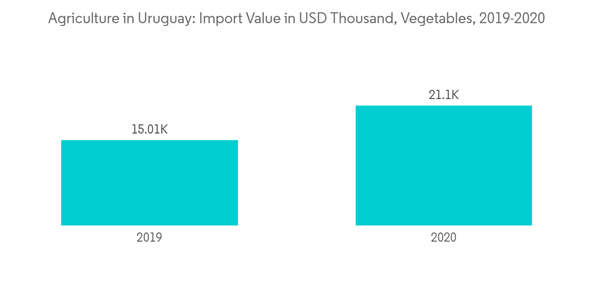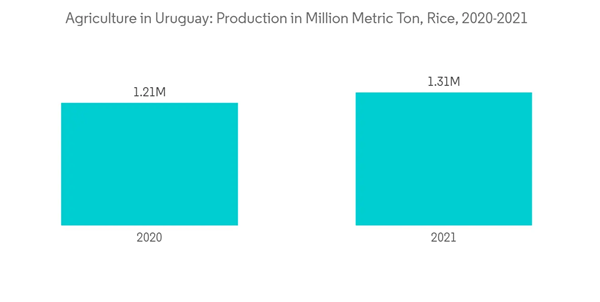The Uruguayan agriculture market is projected to register a CAGR of 4.0% during the forecast period.
This product will be delivered within 2 business days.
Key Highlights
- The factors driving the market are the abundant arable land, which accounts for 16.4 million hectares (93% of the country's total land area) in 2021, and favorable government policies like no limitations or restrictions on the export of agro-industrial goods and further driven by increasing income, rapid urbanization, and a shift in consumers' diet preferences toward nutritional food.
- The agricultural sector is a mainstay of the Uruguayan economy. Agriculture and agri-industry account for 12% of the GDP and about 70% of the total exports. Agriculture in Uruguay has witnessed great changes during the last decade. The food consumption rates in the country are rising, especially among the middle-income group.
- Uruguay's major agricultural products are soybeans, rice, wheat, maize, sorghum, citrus fruits (mainly oranges, tangerines, lemons, and grapefruits), and deciduous fruits (mainly apples, pears, peaches, plums, quince, and nectarines). As a result, rising demand for food crops due to the country's growing population, particularly for fruits and vegetables, is expected to drive the market.
Uruguay Agriculture Market Trends
Demand from the Food and Beverage Industry
- Much of the country's industrial sector is linked to agriculture. About half of all industrial production is based on food processing or refining agricultural products, such as leather. Food and beverage products are the largest single manufacturing sectors, with food processing accounting for 25% of production and beverages accounting for 11% in 2021.
- The nation's principal food processing plants are concentrated in Fray Bentos and Paysanduu. The key markets for processed foods and beverages include Uruguay's MERCOSUR partners. Canaprole, Pepsicola, Saman, and Durulte are the country's leading food and beverage brands.
- Imports of fresh products complement the supply of horticultural products available in the country. The country needs to be self-sufficient in fruit and vegetable production, necessitating imports to meet the growing domestic demand from the food and beverage industries, driving the market's growth.
- Due to the increasing demand from consumers for food and beverage products, these major players are adopting different strategies, such as expansions and product launches. For instance, in 2021, Pepsico invested USD 64 million to expand its beverage concentrates plant in Uruguay's Colonia Free Trade Zone. The company has expanded its industrial area by more than 6,000 square meters. The investment includes upgraded production rooms, expansion of water waste treatment, and an extension of the plant's footprint, which will help PepsiCo expand its zero-sugar offerings.
Rice and Soybean are the Dominating Crops
- Uruguay's soybean area has varied over the years based on crop pricing and export potential. In 2021, the country produced the highest volume of soybean, with 3.07 million metric tons, due to more soybeans being planted than in the previous two years. Planted area is projected to be around 1.1 million hectares in 2022, with a yield of 2.1 metric tons/hectare. The expected harvested area is 15.7% higher than the 2020 harvest area.
- With other summer grains such as sorghum and corn commanding good prices over the last two seasons, fewer soybeans were grown compared to many of the previous years and this year. The volatility of soybean planted area is expected to continue in Uruguay based on the fickle nature of soybean prices and export potential for this country.
- Rice is the staple food in the country.
- Uruguay's rice exports are estimated to be valued at USD 383 million in 2021. Vertical integration and transparency among farmers, millers, researchers, and the government are some of the major factors boosting the rice market in the country.
- In the last few years, wheat farmers have seen high productivity, quality, and profitability levels. Despite higher input and production costs expected for the current season, double cropping with second soybean planting remains profitable.
Uruguay Agriculture Industry Overview
Additional Benefits:
- The market estimate (ME) sheet in Excel format
- 3 months of analyst support
This product will be delivered within 2 business days.
Table of Contents
1 INTRODUCTION
4 MARKET DYNAMICS
5 MARKET SEGMENTATION
Methodology

LOADING...










